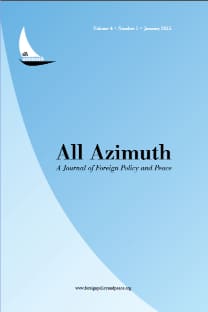Professionalization, Local Military Context, and Reconstruction of the Army in Afghanistan
Security sector reconstruction is a long-debated topic in the peacekeeping and state-building literature. The primary goal of any reconstruction program in conflict-ridden countries is to build up security institutions, which are prerequisites for sustainable development and democratization. This study aims to examine how security sector institutions, specifically the armed forces, have been reconstructed by intervening actors in post-conflict countries like Afghanistan. It argues that army reconstruction programs that are developed without any elaboration of the peculiar conditions of the related post-conflict countries, are unlikely to be successful. As such, initiatives aimed at security sector reconstruction need to take account of the idiosyncratic characteristics of the conflict affected country and its institutions, and the program should be devised conforming to the case-specific circumstances. This research aims to identify reliable evidence to support this argument by analyzing data collected from both primary and secondary resources. It also aims to contribute methodologically by building upon the first-hand impressions of practitioners from various countries over their reconstruction activities.
Keywords:
Afghanistan, reconstruction, security, army professionalization,
___
- Ansorg, Nadine, and Eleanor Gordon. “Co-operation, Contestation and Complexity in Post-Conflict Security Sector Reform.” Journal of Intervention and Statebuilding 13, no.1 (2019): 2–24.
- Bellin, Eva. “The Robustness of Authoritarianism in the Middle East.” Comparative Politics 36, no. 2 (2004): 139–57.
- Bensahel, Nora. “Mission Not Accomplished: What Went Wrong with Iraqi Reconstruction.” The Journal of Strategic Studies 29, no. 3 (2006): 453–73.
- Brzoska, Michael. “Introduction: Criteria for Evaluating Post-Conflict Reconstruction and Security Sector Reform in Peace Support Operations.” International Peacekeeping 13, no. 1 (2006): 1–13.
- Brzoska, Michael, and Andreas Heinemann-Grüder. “Security Sector Reform and Post-Conflict Reconstruction under International Auspices.” In Reform and Reconstruction of the Security Sector, edited by Alan Bryden and Heiner Hänggi, 121–42. Geneva: Center for the Democratic Control of Armed Forces, 2004.
- Chanaa, Jane. Security Sector Reform: Issues, Challenges and Prospects. New York: Oxford University Press, 2002.
- Cronin, Stephanie. Armies and State-building in the Modern Middle East: Politics, Nationalism and Military Reform. London: I.B. Tauris, 2014.
- Fukuyama, Francis. “Building Democracy After Conflict: Stateness First.” Journal of Democracy 16, no.1 (2005): 84–8.
- Gaub, Florence. Rebuilding Armed Forces: Learning from Iraq and Lebanon. Carlisle: Strategic Studies Institute, 2011.
- Giustozzi, Antonio. “Auxiliary Force or National Army? Afghanistan’s ‘ANA’ and the Counter-Insurgency Effort, 2002–2006.” Small Wars and Insurgencies 18, no. 1 (2007): 45–67.
- Grissom, Adam. “Shoulder-to-Shoulder Fighting Different Wars: NATO Advisors and Military Adaptation in the Afghan National Army 2001-2011.” In Military Adaptation in Afghanistan, edited by Theo Farrell, Frans Osinga, and James A. Russell, 263–87. California: Stanford University Press, 2013.
- Hänggi, Heiner. “Conceptualizing Security Sector Reform and Reconstruction.” In Reform and Reconstruction of the Security Sector, edited by Alan Bryden and Heiner Hänggi, 1–11. Geneva: Center for the Democratic Control of Armed Forces, 2004.
- Hänggi, Heiner, and Vincenza Scherrer. “Towards an Integrated Security Sector Reform Approach in UN Peace Operations.” International Peacekeeping 15, no. 4 (2008): 486–500.
- Huntington, Samuel. The Soldier and the State: The Theory and Politics of Civil-Military Relations. Cambridge: Harvard University Press, 1957.
- Jackson, Paul. “Security Sector Reform and State Building.” Third World Quarterly 32, no. 10 (2011): 1803–22.
- Jalali, Ali A. “Rebuilding Afghanistan’s National Army.” Parameters 32, no. 3 (2002): 72–86.
- Janowitz, Morris. The Professional Soldier: A Social and Political Portrait. New York: Free Press, 1971.
- Kamrava, Mehran. “Military Professionalization and Civil Military Relations in the Middle East.” Political Science Quarterly 115, no. 1 (2000): 67–92.
- Kumar, Ranjit. Research Methodology. London: Sage Publications, 1999.
- Livingston, Ian S., and Michael O’Hanlon. Brookings Institution Afghanistan Index, September 29, 2017. Accessed 19 September, 2019. https://www.brookings.edu/wp-content/uploads/2016/07/21csi_20171002_afghanistan_index.pdf.
- Moskos, Charles C. “Institutional/Occupational Trends in Armed Forces: An Update.” Armed Forces and Society 12, no. 3 (1986): 377–82.
- Reference Number A161017, “interview with advisor and staff officer,” October 2017.
- Reference Number A251117, “interview with staff officer,” November 2017.
- Reference Number B41017, “interview with civilian advisor,” November 2017.
- Reference Number B61117, “interview with advisor and staff officer,” November 2017.
- Reference Number B71117, “interview with staff officer,” November 2017.
- Resolute Support (RS) Afghanistan. Mission. Accessed July 27, 2018. https://rs.nato.int/about-us/mission.aspx.
- Rosen, Stephen P. “Military Effectiveness: Why Society Matters.” International Security 19, no. 4 (1995): 5–31.
- Schnabel, Albrecht, and Hans Georg Ehrhart. “Post-conflict Societies and the Military: Challenges and Problems of Security Sector Reform.” In Security Sector Reform and Post Conflict Peacebuilding, edited by Albrecht Schnabel and Hans Georg Ehrhart, 1–16. Tokyo: United Nations University Press, 2005.
- Sedra, Mark. “Consolidating an Elusive Peace: Security Sector Reform in Afghanistan.” In Reform and Reconstruction of the Security Sector, edited by Alan Bryden and Heiner Hänggi, 207–23. Geneva: Center for the Democratic Control of Armed Forces, 2004.
- ———. “Security Sector Reform in Afghanistan and Iraq: Exposing a Concept in Crisis.” Journal of Peacebuilding & Development 3, no. 2 (2007): 7–23.
- ———. Security Sector Reform in Conflict-Affected Countries: The Evolution of a Model. London: Routledge, 2017.
- Special Inspector General for Afghanistan Reconstruction (SIGAR). Quarterly Report to the United States Congress. July 30, 2014. Accessed July 31, 2019. https://www.sigar.mil/pdf/quarterlyreports/2014-07-30qr.pdf.
- Special Inspector General for Afghanistan Reconstruction (SIGAR). Reconstructing the Afghan National Defense and Security Forces: Lessons from the US Experience in Afghanistan. September 23, 2017. Accessed July 17, 2019. https://www.sigar.mil/AllReports/.
- The Asia Foundation. A Survey of the Afghan People: Afghanistan in 2018. Accessed September 11, 2019. https://asiafoundation.org/wp-content/uploads/2018/12/2018_Afghan-Survey_fullReport-12.4.18.pdf.
- The OECD /DAC Handbook on Security System Reform: Supporting Security and Justice. Paris: OECD Publishing, 2007.
- United States Institute of Peace. “Afghanistan 2017: A Survey of Public Perceptions November 23, 2017. Accessed July 12, 2019. Video, https://www.usip.org/events/afghanistan-2017-survey-public-perceptions.
- Uppsala Conflict Data Program. “Afghanistan.” Accessed September 15, 2019. https://ucdp.uu.se/country/700.
- ISSN: 2146-7757
- Yayın Aralığı: Yılda 2 Sayı
- Başlangıç: 2012
- Yayıncı: Dış Politika ve Barış Araştırmaları Merkezi, İhsan Doğramacı Barış Vakfı
